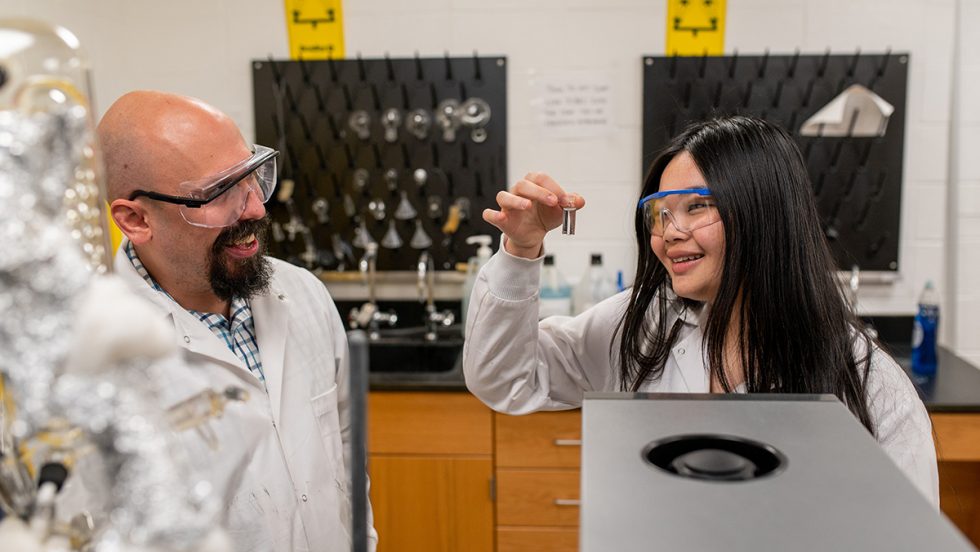
A collaboration between two faculty members and 10 undergraduates provides valuable new information about HVI reagents.
Assistant professor of chemistry Daniel L. Silverio, PhD, and associate professor of chemistry Ivan Hyatt, PhD, were intrigued by the challenge of enhancing the solubility and reactivity of hypervalent iodine (HVI) reagents, environmentally friendly compounds that have been of limited use to industry due to their poor solubility. As testing the ability of different chemical compounds to dissolve in solvents requires significant amounts of lab time, the two recruited their undergraduate students as research partners.
The project had two challenges. “One, we needed to make these more soluble reagents, and two, we needed to get a baseline solubility of the common reagents that are used today,” Dr. Silverio said. “Although researchers talk about solubility all the time, no one cites actual numbers.” Very little data measuring the relative solubility of HVI reagents exists, so the research team had to start from scratch.
In Dr. Hyatt’s lab, students developed techniques for synthesizing the compounds needed for their research. Dr. Silverio’s team worked on analyzing the solubility of the compounds.
Together, they found that compounds containing longer chains of carbon atoms were “more soluble in nonpolar solvents like ether and hexane” than those with shorter chains. The resulting article, “Ligand exchange of aryl iodine dicarboxylates to form reagents with differing solubilities” (Arkivoc, April 7, 2021),1 draws the conclusion that “novel HVI compounds can be used in solvents that otherwise would be unsuitable to traditional reactions with HVI reagents.” Drs. Hyatt and Silverio share authorship with 10 of the undergraduate students who conducted much of the research.
According to Dr. Hyatt, the project required students to learn research techniques that are rarely utilized in undergraduate labs. Students were carefully trained on different methods of producing the samples, for instance, which allowed them to discover that the ligand exchange method provided a high yield and low purity, while the oxidation method produced a low yield and high purity. This proved to be critical for the accurate assessment of the compounds’ solubility.
“Our students were doing a spectroscopic analysis on some of these compounds, which are closer to industrial techniques for analysis,” Dr.Hyatt said. “It’s not what undergraduate students would normally be doing in a lab.”
Senior Christina Callov was one of the students in Dr. Hyatt’s group. She was excited to be part of such a rigorous research project and was especially pleased with the training she and other students received and the results that training led to. “Every reaction I ran to produce HVI was successful,” she said.“When doing research, not every reaction works, so it was really nice to have such success with synthesizing these compounds.”
Vanie Seecharan, a junior and member of Dr. Silverio’s team, was lead author on the article. Before joining the project, she was torn between pursuing graduate school, medical school or both. “During the course of this project, I learned thatI love working in a lab, problem-solving and thinking about new experiments,” she said. “Through this research, I was able to find a new passion for chemistry, which has motivated me to pursue a graduate degree.”
While cataloging the relative solubility of HVI reagents will be useful for other researchers, Drs. Hyatt and Silverio believe it will also have important applications outside the lab. “This definitely isn’t one of those projects where you have some interesting results, but there are no practical uses,” said Dr. Silverio. “This is something that people are going to be able to use immediately, especially for industrial chemists who will finally have some data to work with.”
With results in hand, they are now studying reagents that could be even more soluble, such as liquid HVI compounds that could allow industrial chemists to run HVI reactions without the use of a solvent. “It turns out that it’s difficult to test the solubility of liquids,”said Dr. Silverio. “But we’ve come up with new methods that are giving us pretty reliable data.”
1 Seecharan, Vanie, and Lyse Armand, Jennifer Noorollah, Nirvanie Singh, Andrew Zhang, Kevin P. Freddo, Nicholas Spatola, Sailesh Prasad, Azka Chaudhry, Su Wint War, I. F. Dempsey Hyatt, and Daniel L. Silverio. “Ligand exchange of aryl iodine dicarboxylates to form reagents with differing solubilities.” Arkivoc, part iv, 7 April 2021, pp. 79-85.